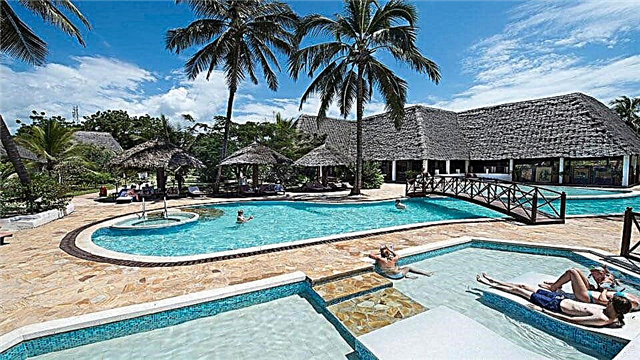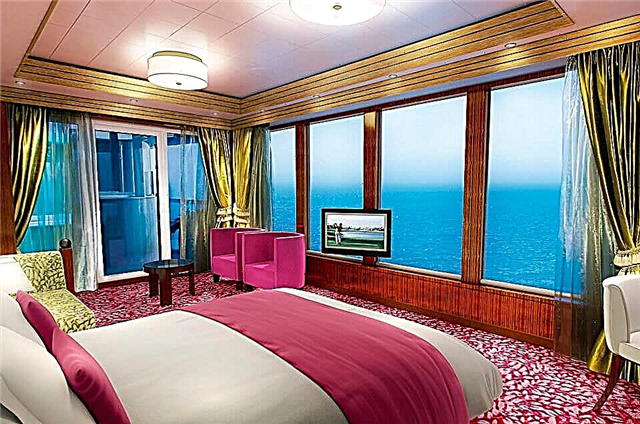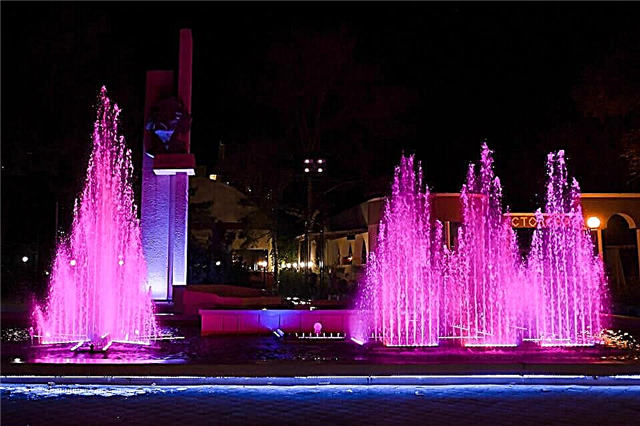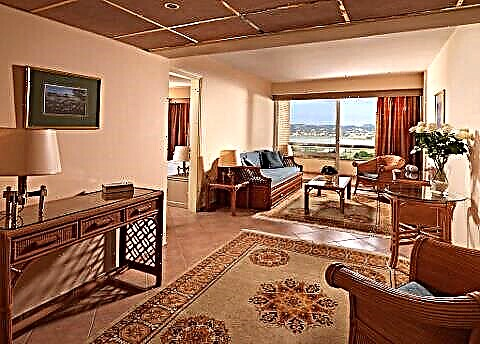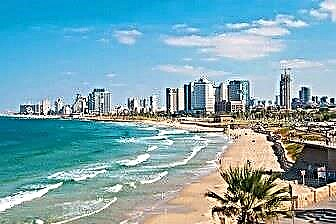Tel Aviv is known as one of the best seaside resorts in Israel. Moreover, the city is the business, cultural and economic center of Israel, so it is constantly evolving and transforming. In addition to magnificent beaches, Tel Aviv can offer tourists an exciting excursion program with a visit to the ancient quarters of Jaffa, the old port and the picturesque Neve Tzedek area.
Tel Aviv is a dynamic and modern city that preserves old traditions and at the same time is open to new trends. On the picturesque city embankment, dozens of trendy clubs and restaurants await tourists, ghosts of previous centuries hover in the narrow stone streets of Jaffa, the amazing collection of the Museum of the Diaspora is saturated with the spirit of the thousand-year wanderings of the Jewish people, who found their homeland only in the middle of the 20th century.

The best hotels and hotels at affordable prices.
from 500 rubles / day
What to see and where to go in Tel Aviv?
The most interesting and beautiful places for walking. Photos and a short description.
Jaffa Old Town
Jaffa is one of the oldest cities in the world. The first settlements on its territory existed in the 17th-16th centuries BC. The city flourished in ancient times, but was destroyed during the Jewish War. The restoration took place under the Emperor Vespasian. During the Arab rule and subsequent Crusades, Jaffa continued to develop as an important port. In 1268, the city was destroyed by the troops of Sultan Baybars I, after which it lay in ruins for 400 years. In the middle of the 20th century, Jaffa was merged with Tel Aviv.

Old Tel Aviv Port
Tel Aviv Sea Harbor operated from 1938 to 1965. After the closure, the port remained abandoned for thirty years until it was converted into a tourist area in the 1990s. Today, restaurants, shops and entertainment establishments are open here, and comfortable walking areas are organized for visitors. An antique market is open once a week in the harbor area.

Azrieli Center
A modern complex consisting of three skyscrapers - a triangular tower (169 meters), a round tower (187 meters) and a square tower (154 meters). All structures were erected in the period 1996-2007. The complex was named after D. Azrieli, an Israeli entrepreneur who took part in the creation of the project. There is a panoramic observation deck on the 49th floor of the round tower, from where you can look at Tel Aviv from a height of 182 meters.

Neve Tzedek
In the 19th century, the first Jewish settlement outside Jaffa was located on the territory of the modern district of Neve Tzedek. Land for building houses was bought from Muslims. Gradually emigrants from Europe came here and built their homes, so the streets began to resemble the quarters of Krakow, Munich and Prague at the same time. During the 20th century, the area fell into disrepair, but was revived again in the 1990s.

White City
A group of districts in the central part of Tel Aviv, where houses are predominantly white in color. The main development of this part of the city was carried out in 1920-1950 in the then popular post-war Bauhaus style, which implies functionality, convenience and minimalism. The White City was included in the UNESCO World Heritage List as a monument of urban planning of the 20th century.

House-pagoda in Tel Aviv
Built in 1925, which combines features of several architectural styles. The house was erected by A. Levy for the wealthy city dweller M. Bloch. An interesting story is connected with its creation, according to which Bloch rejected Levy's original plan and turned to an American architect. But the latter did not take into account the peculiarities of the local architecture, so his project was rejected. Then Bloch came to Levi again. In retaliation, the architect created a building where he mixed the styles of different eras.

Palmach Museum
The exposition is dedicated to the history of the Jewish military units "Palmach", created in 1941 to repel a possible attack of the Third Reich on Palestine. The divisions existed until 1948, when they were incorporated into the newly created Israel Defense Forces. The museum has an interactive format. With the help of videos, projections and special effects, visitors are shown the "revived" story.

Diaspora Museum
The opening of the museum was timed to coincide with the 30th anniversary of the founding of the Israeli state. Its collection is made up of exhibits through which you can study the history of the Jewish diaspora scattered around the world. The wanderings of the Jews began 2,600 years ago, when King Nebuchadnezzar II took Jerusalem and began to forcefully remove the Jews from their ancestral lands. The exposition is dedicated to various aspects of the life of Israelis in other countries.

Eretz Israel Museum
Archaeological and Anthropological Museum, consisting of extensive collections of historical artifacts found in the lands of Israel. The exposition consists of several pavilions, where ceramics, jewelry, coins, dishes, mosaics, tools and other items are located. The museum was established in 1953, five years after Israel was declared a separate state.

Tel Aviv Museum of Fine Arts
A large art gallery, where paintings, photographs, graphic drawings, sculptures are exhibited. Separate exhibitions are devoted to design and architecture. The museum was created in 1932 on the territory of the house of M. Dizengoff, the mayor of Tel Aviv. Today it is a whole museum complex, consisting of several pavilions and a full-fledged educational center.

Ilana Gur Museum
Ilana Gur is a self-taught artist and passionate art connoisseur, gifted with extraordinary abilities since childhood. Due to the peculiarities of development (dyslexia), she was forced to independently comprehend entire layers of knowledge. During her life, Ilana Gur created works from various materials, giving preference to metal. The museum was opened in 1995 in one of the old quarters of Jaffa in a house where a hotel for pilgrims previously worked.

Israel Defense Forces Museum
Israel's main military museum, founded in the 1950s by D. Ben-Gurion, one of the founders of the Israeli state. The museum collection consists of various weapons, ammunition, equipment and military trophies obtained, including in the process of confronting terrorist organizations. A separate part is dedicated to the collection of gifts received by the ministers of defense and the fleet of government cars.

Jaffa clock tower
The tower was erected at the beginning of the 20th century with donations from the inhabitants of Jaffa in honor of the anniversary of the coronation of the Ottoman Sultan Abdul Hamid II (at that time the territory of Tel Aviv belonged to the Ottoman Empire). The structure was the first civilian building to house a dial. Until then, clocks were only installed on minarets or church bell towers.

Sarona Market
Covered market, on the territory of which you can "profit" with delicacies. Its many shops sell vegetables, fruits, sweets, cheese, meat, seafood, fish. There are also cafes, wine boutiques with a large selection of drinks and tea shops on the market. A branch of the Bishulim culinary school operates at Sarona Market, where master classes on cooking unusual dishes are held.

Carmel Market
The lively Shuk HaCarmel was founded in 1920. Over the years, it has become the largest bazaar in Tel Aviv. The first sellers were Jewish immigrants from Russia who came to Israel after 1917. They opened small shops near their homes and sold groceries with household utensils.Today, almost all residents of Tel Aviv go to the market, as prices are lower here than in stores.

Flea market in Jaffa
A place where they sell antiques brought from different countries. Here you can find things that once belonged to emigrants of the early 20th century, mixed with completely useless junk. It will take a lot of time to find something worthwhile, but the efforts will be rewarded, and the tourist will become the happy owner of a valuable item. The flea market is one of the most "colorful" places in Tel Aviv.

Hanging orange tree
A pot suspended on ropes, inside of which an orange tree grows. It is one of the symbols of the country. The fact is that after the formation of a separate state, Israel began to intensively export oranges, which allowed it to receive good incomes and settle many economic problems. The local citrus variety appeared at the end of the 19th century and was named "Jaffa".

Yarkon River and Park
The park is located in the northern part of Tel Aviv along the river of the same name. It consists of six thematic areas, including a rock garden, a cactus garden and a tropical garden. The park has a variety of activities such as water attractions, a bird's corner, sports fields, a playground and a go-kart track. You can come here to just lie on the green lawn and read a book or stroll along the shady alleys.

Tel Aviv waterfront
The entertainment infrastructure of Tel Aviv is concentrated on the embankment. Even on traditional Jewish holidays, you can find working establishments here. During the day, it is nice to sunbathe on a comfortable sandy beach, in the evening - take a leisurely walk along the line of hotels, restaurants and shops, at night - dance in one of the nightclubs to the music of fashionable DJs.

Tel Aviv beaches
Tel Aviv is not only the cultural and economic center of Israel, it is also a popular Mediterranean resort. The entire western border of the city is a continuous strip of sand. The city beaches are covered with light sand and are equipped with all the necessary infrastructure for a comfortable stay of visitors. There is even a special beach on the coast for Orthodox Jews.


